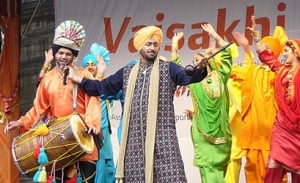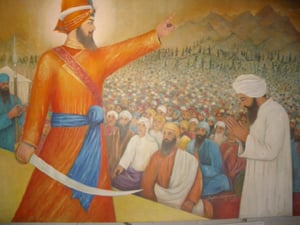Significance of Vaisakhi
For many 1000's of years, April has been the time when farmers have put their sickles to harvest and collected the precious life saving crops. In the countryside, during this time, the fragrance of the harvest is ubiquitous with scenes of many large piles of grains in one corner of the field; the stacks of wheat stalks ready as fodder for the cattle in another and the general urgency and excitement of the hustle and bustle of transporting and selling of the farm commodity by the farmers. Without a good harvest, communities would perish and so there was always great joy when a good harvest resulted at Vaisakhi time. Spring season has always been an important and decisive time for the people of the northern hemisphere from times immemorial. During historical times, much had depended on the outcome of the harvest.
However, since 1699, the Sikhs have had a further reason to celebrated at this time of the year. Now Vaisakhi is celebrated with even more energy, pomp and fanfare. It has become a holy day to mark the birth of the Khalsa fraternity. And so 300 years on, this traditions continues with much gaiety, vigour and enthusiasm. Sikhs worldwide will justifiable spend much time remembering this most important day in their religious calendar – the day the Khalsa was created.
The religious remembrance mixed with the remnant of the harvest festivals of Punjab combine to make this an exciting and particularly festive time for all. Celebrations of many different type take place - many Nagar kirtans will be arranged in many large cities both in the west and in India; lots of Langars will be held in many Gurdwaras ; and holy Paaths will also be undertaken where the sacred verses of Sri Guru Granth Sahib will be recited. With these religious events on the one hand will be combined Bhangra dancing, [[Vaisakhi] Dinner and dance functions and much drinking and partying by the non-Gurdwara going community. Under the volumes of such a terrific amount of fun and celebrations have we forgotten the real significance of Vaisakhi? Has the real message of Vaisakhi of 1699 been lost?
If we take ourselves back to 1699 and the birth place of the Khalsa perhaps the real significance of Vaisakhi can be comprehended. During the period around 1650, the country around Punjab was in turmoil; the rulers were corrupt; there was no rule of law; the rights of the common people were tramped on; justice did not prevail. The strong imposed their will and their way without question; the weak suffered constantly and quietly; there was misery everywhere. The weakest were slaughtered daily and no one heard their screams; the rich were accountable to no one and their wishes prevailed; higher authority could be easily bought with money and wealth; for the average person, no peace could be guaranteed; people lived like animals; fear gripped many nations. The minority ruled by imposing terror upon the common people; death was never far away from your thoughts.
It was under these circumstances that Guru Gobind Singh rose to the occasion and chose to create the Khalsa – the pure saint soldier. The Guru was looking for special people within the community who would take on the challenge and rise above the weakness of the common people; to be strong and fearless; to be prepared to face these challenges without reservation and without resorting to injustice; to be fair and even handed at all times; to be prepare to die for the truth. The Guru says the following about the Khalsa:
The Khalsa is my true image. I dwell in the Khalsa.
Khalsa is my chief purpose. I am forever with the Khalsa.
Khalsa is my closest friend. Khalsa is my mother, father & my comfort.
Khalsa is my caste & creed. My creation is through the Khalsa.
Khalsa is my haven and storehouse. Because of the Khalsa I am honoured.
Khalsa is my body & spirit. Khalsa is my life & soul.
Khalsa is my total, true Guru. Khalsa is my courageous friend.
Khalsa is my wisdom & knowledge. I will always contemplate for the Khalsa.
Full tribute of the Khalsa is beyond me. It is impossible to truly praise the Khalsa with one tongue.
I certify that in the above, nothing is false. God and Guru Nanak are my witnesses to this truth.
The Guru had a vision to create a human being who would hold dear the message of all the previous Gurus and who would be able and be strong enough to see their mission through. Guru ji clearly states that his mission on earth was very clear. In the Dasam Granth (Page 136), Maharaj says:
When I was busy in the austere devotion, the Lord called me and sent me to this world with the following words.28.
The Word of the Non-Temporal Lord: Chaupai:
I have adopted you as my son and hath created you for the propagation of the path (Panth).
"You go therefore for the spread of Dharma (righteousness) and cause people to retrace their steps from evil actions".29.
Kabebach: Dohra
I stood up with folded hands and bowing down my head, I said: "The path (Panth) shall prevail only in the world, with THY ASSISTANCE."30.
So the tenth Guru chose April and in particular Vaisakhi in 1699 to ask for the Sangat (congregation) to make a commitment to the Panth (community) and join his army of Saint Soldier. Their mission was to help in the spread of Dharma and to stop the spread of evil and sin. The passage of time does not diminish the significance of this call from the Sikh master. It is call to all the peoples of the world. He call requires the community to join his specialist army unit to defend and nurture the high principles set by the Gurus. The Gurus promoted the principles of equality, compassion, love and peace, humility and contentment, devotion to truth, protection of the weak, the sharing of resources, right to work, right to free worship and remembrance of God, etc. The real significance of Vaisakhi is to heed the call from the Guru. If you are already an Amritdhari Sikh, renew your duties to the Panth and if you have not taken Amrit yet, then this is the time to listen carefully to that loud call of the Guru in 1699. What is call saying? "I want the head of one dedicated Sikh!" Why not make it your head this year and become a fighter in the army of Guru Gobind Singh.
The evil in the world continues to increase:- hatred; war; terrorism; unrest; lawlessness, etc and all the other enemies of Dharma continue to increase. The need for Guru's Khalsa is there even today. So become a Singh or Kaur and become part of the family of Guru Gobind Singh and Mata Sahib Kaur and realise the significance of Vaisakhi!


